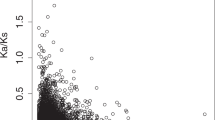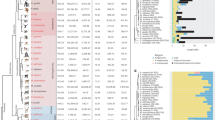Abstract
In birds, as in mammals, one pair of chromosomes differs between the sexes. In birds, males are ZZ and females ZW. In mammals, males are XY and females XX. Like the mammalian XY pair, the avian ZW pair is believed to have evolved from autosomes, with most change occurring in the chromosomes found in only one sex—the W and Y chromosomes1,2,3,4,5. By contrast, the sex chromosomes found in both sexes—the Z and X chromosomes—are assumed to have diverged little from their autosomal progenitors2. Here we report findings that challenge this assumption for both the chicken Z chromosome and the human X chromosome. The chicken Z chromosome, which we sequenced essentially to completion, is less gene-dense than chicken autosomes but contains a massive tandem array containing hundreds of duplicated genes expressed in testes. A comprehensive comparison of the chicken Z chromosome with the finished sequence of the human X chromosome demonstrates that each evolved independently from different portions of the ancestral genome. Despite this independence, the chicken Z and human X chromosomes share features that distinguish them from autosomes: the acquisition and amplification of testis-expressed genes, and a low gene density resulting from an expansion of intergenic regions. These features were not present on the autosomes from which the Z and X chromosomes originated but were instead acquired during the evolution of Z and X as sex chromosomes. We conclude that the avian Z and mammalian X chromosomes followed convergent evolutionary trajectories, despite their evolving with opposite (female versus male) systems of heterogamety. More broadly, in birds and mammals, sex chromosome evolution involved not only gene loss in sex-specific chromosomes, but also marked expansion and gene acquisition in sex chromosomes common to males and females.
This is a preview of subscription content, access via your institution
Access options
Subscribe to this journal
Receive 51 print issues and online access
$199.00 per year
only $3.90 per issue
Buy this article
- Purchase on Springer Link
- Instant access to full article PDF
Prices may be subject to local taxes which are calculated during checkout



Similar content being viewed by others
Accession codes
Data deposits
Predicted Z-amplicon transcript sequences and the complete assembled sequence of the Z chromosome are available at http://jura.wi.mit.edu/page/papers/Bellott_et_al_2010/ (see Supplementary Table 5 for GenBank accession numbers).
References
Muller, H. J. A gene for the fourth chromosome of Drosophila . J. Exp. Zool. 17, 325–336 (1914)
Ohno, S. Sex Chromosomes and Sex-Linked Genes (Springer, 1967)
Lahn, B. T. & Page, D. C. Four evolutionary strata on the human X chromosome. Science 286, 964–967 (1999)
Skaletsky, H. et al. The male-specific region of the human Y chromosome is a mosaic of discrete sequence classes. Nature 423, 825–837 (2003)
Ross, M. T. et al. The DNA sequence of the human X chromosome. Nature 434, 325–337 (2005)
Nanda, I. et al. 300 million years of conserved synteny between chicken Z and human chromosome 9. Nature Genet. 21, 258–259 (1999)
Nanda, I., Haaf, T., Schartl, M., Schmid, M. & Burt, D. W. Comparative mapping of Z-orthologous genes in vertebrates: implications for the evolution of avian sex chromosomes. Cytogenet. Genome Res. 99, 178–184 (2002)
International Chicken Genome Sequencing Consortium Sequence and comparative analysis of the chicken genome provide unique perspectives on vertebrate evolution. Nature 432, 695–716 (2004)
Grützner, F. et al. In the platypus a meiotic chain of ten sex chromosomes shares genes with the bird Z and mammal X chromosomes. Nature 432, 913–917 (2004)
Rens, W. et al. Resolution and evolution of the duck-billed platypus karyotype with an X1Y1X2Y2X3Y3X4Y4X5Y5 male sex chromosome constitution. Proc. Natl Acad. Sci. USA 101, 16257–16261 (2004)
Ezaz, T., Stiglec, R., Veyrunes, F. & Marshall Graves, J. A. Relationships between vertebrate ZW and XY sex chromosome systems. Curr. Biol. 16, R736–R743 (2006)
Smith, J. J. & Voss, S. R. Bird and mammal sex-chromosome orthologs map to the same autosomal region in a salamander (Ambystoma). Genetics 177, 607–613 (2007)
Hori, T. et al. Characterization of DNA sequences constituting the terminal heterochromatin of the chicken Z chromosome. Chromosome Res. 4, 411–426 (1996)
Kasahara, M. et al. The medaka draft genome and insights into vertebrate genome evolution. Nature 447, 714–719 (2007)
Lander, E. S. et al. Initial sequencing and analysis of the human genome. Nature 409, 860–921 (2001)
Scanlan, M. J., Simpson, A. J. & Old, L. J. The cancer/testis genes: review, standardization, and commentary. Cancer Immun. 4, 1 (2004)
Wheeler, D. L. et al. Database resources of the National Center for Biotechnology Information. Nucleic Acids Res. 33, D39–D45 (2005)
Saifl, G. M. & Chandra, H. S. An apparent excess of sex- and reproduction-related genes on the human X chromosome. Proc. R. Soc. Lond. B 266, 203–209 (1999)
Wichman, H. A., Bussche, R. A., Hamilton, M. J. & Baker, R. J. Transposable elements and the evolution of genome organization in mammals. Genetica 86, 287–293 (1992)
Wyckoff, G. J., Wang, W. & Wu, C. I. Rapid evolution of male reproductive genes in the descent of man. Nature 403, 304–309 (2000)
Swanson, W. J. & Vacquier, V. D. The rapid evolution of reproductive proteins. Nature Rev. Genet. 3, 137–144 (2002)
Rice, W. R. Sex chromosomes and the evolution of sexual dimorphism. Evolution 38, 735–742 (1984)
Filatov, D. A. Evolutionary history of Silene latifolia sex chromosomes revealed by genetic mapping of four genes. Genetics 170, 975 (2005)
Handley, L. J. L., Ceplitis, H. & Ellegren, H. Evolutionary strata on the chicken Z chromosome: implications for sex chromosome evolution. Genetics 167, 367 (2004)
Nicolas, M. et al. A gradual process of recombination restriction in the evolutionary history of the sex chromosomes in dioecious plants. PLoS Biol. 3, e4 (2005)
Wallis, J. W. et al. A physical map of the chicken genome. Nature 432, 761–764 (2004)
Morisson, M. et al. ChickRH6: a chicken whole-genome radiation hybrid panel. Genet. Sel. Evol. 34, 521–533 (2002)
Saxena, R. et al. Four DAZ genes in two clusters found in the AZFc region of the human Y chromosome. Genomics 67, 256–267 (2000)
Kent, W. J. BLAT–the BLAST-like alignment tool. Genome Res. 12, 656–664 (2002)
Hubbard, T. J. et al. Ensembl 2009. Nucleic Acids Res. 37, D690–D697 (2009)
Korf, I., Flicek, P., Duan, D. & Brent, M. R. Integrating genomic homology into gene structure prediction. Bioinformatics 17 (suppl. 1). S140–S148 (2001)
Flicek, P., Keibler, E., Hu, P., Korf, I. & Brent, M. R. Leveraging the mouse genome for gene prediction in human: from whole-genome shotgun reads to a global synteny map. Genome Res. 13, 46–54 (2003)
Altschul, S. F., Gish, W., Miller, W., Myers, E. W. & Lipman, D. J. Basic local alignment search tool. J. Mol. Biol. 215, 403–410 (1990)
Lowe, T. M. & Eddy, S. R. tRNAscan-SE: a program for improved detection of transfer RNA genes in genomic sequence. Nucleic Acids Res. 25, 955–964 (1997)
Benson, D. A., Karsch-Mizrachi, I., Lipman, D. J., Ostell, J. & Sayers, E. W. GenBank. Nucleic Acids Res. 37, D26–D31 (2009)
Griffiths-Jones, S., Saini, H. K., van Dongen, S. & Enright, A. J. miRBase: tools for microRNA genomics. Nucleic Acids Res. 36, D154–D158 (2008)
Smit, A. F. A., Hubley, R. & Green, P. RepeatMasker Open-3.0. 〈http://www.repeatmasker.org〉 (2007)
Kuroda-Kawaguchi, T. et al. The AZFc region of the Y chromosome features massive palindromes and uniform recurrent deletions in infertile men. Nature Genet. 29, 279–286 (2001)
Boardman, P. E. et al. A comprehensive collection of chicken cDNAs. Curr. Biol. 12, 1965–1969 (2002)
Acknowledgements
We thank E. Rapoport for technical assistance, S. Repping and S. van Daalen for experimental advice, and E. Anderson, T. Endo, M. Gill, A. Hochwagen, C. Hongay, Y. Hu, J. Hughes, J. Marszalek, J. Mueller and Y. Soh for comments on the manuscript. We thank the Broad Institute Genome Sequencing Platform and Genome Sequencing and Analysis Program, F. Di Palma and K. Lindblad-Toh for making the unpublished data for Gasterosteus aculeatus available. This work was supported by the National Institutes of Health and the Howard Hughes Medical Institute.
Author information
Authors and Affiliations
Contributions
D.W.B., H.S., W.C.W., S.R., R.K.W. and D.C.P. planned the project. D.W.B. and L.G.B. performed BAC mapping. D.W.B. performed RT–PCR analysis. T.G. and C.K. were responsible for finished BAC sequencing. D.W.B. and H.S. performed comparative sequence analyses. T.P. performed FISH analysis. E.R.M. performed 454 sequencing. D.W.B. and D.C.P. wrote the paper.
Corresponding author
Ethics declarations
Competing interests
The authors declare no competing financial interests.
Supplementary information
Supplementary Information
This file contains Supplementary Figures 1-12 with legends (please note that Supplementary Figure 1 spans 24 pages), Supplementary Tables 1-5 and Supplementary Notes 1, which gives additional information about Supplementary Figure 12. (PDF 25983 kb)
Rights and permissions
About this article
Cite this article
Bellott, D., Skaletsky, H., Pyntikova, T. et al. Convergent evolution of chicken Z and human X chromosomes by expansion and gene acquisition. Nature 466, 612–616 (2010). https://doi.org/10.1038/nature09172
Received:
Accepted:
Published:
Issue Date:
DOI: https://doi.org/10.1038/nature09172
This article is cited by
-
RNA stability controlled by m6A methylation contributes to X-to-autosome dosage compensation in mammals
Nature Structural & Molecular Biology (2023)
-
High male specific contribution of the X-chromosome to individual global recombination rate in dairy cattle
BMC Genomics (2022)
-
Improving clinical outcomes through attention to sex and hormones in research
Nature Reviews Endocrinology (2021)
-
The X chromosome and male infertility
Human Genetics (2021)
-
Massive gene amplification on a recently formed Drosophila Y chromosome
Nature Ecology & Evolution (2019)
Comments
By submitting a comment you agree to abide by our Terms and Community Guidelines. If you find something abusive or that does not comply with our terms or guidelines please flag it as inappropriate.



